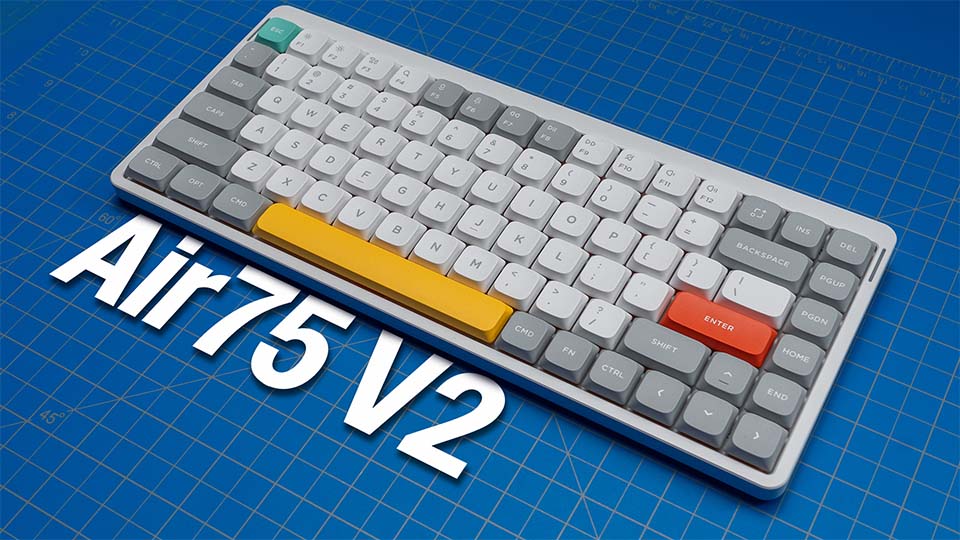Links in this post may be affiliate links. Any products purchased through affiliate links may provide a small commission which helps to support the SemiPro Tech+Gear site and YouTube channel.
The original NuPhy Air75 was, in my opinion, one of the best options on the market for a 75% low profile mechanical keyboard. The V2 now makes improvements in several key areas that were potential drawbacks to the original. Is it still the top choice?
NuPhy clearly listened to feedback about the original Air75, because the upgrades with V2 take direct aim at the things most commonly cited as downsides by myself and many others. There’s no doubting that V2 is an overall improvement, but deciding whether to upgrade for current V1 owners is not necessarily an easy call.
NuPhy Air75 V2
MSRP: $119.95 (Gateron switches) / $129.95 (NuPhy switches)
Pros
- Added QMK/VIA compatibility
- Adjustable feet and still works on a laptop deck
- Typing feel & sound are more refined from V1
- 2.4GHz connection is now 1,000Hz polling rate
- More color choices than V1
Cons
- No ISO layout option
- No built-in storage for 2.4GHz receiver
Best For: Everyone using an ANSI layout. The Air75 V2 is my top recommendation for a 75% low profile mechanical keyboard.
Use code SEMIPRO for 10% off at NuPhy
What’s Better
The big-ticket upgrade is QMK/VIA compatibility. All previous NuPhy keyboards in the Air and Halo line have used NuPhy Console software for customizing the key layout, adding macros, and controlling lighting effects. The issue with NuPhy Console was that it is only available on Windows, and even for Windows users the software was full of quirks and usability issues. Thankfully, NuPhy chose to go with the feedback on this and opted for the open-source QMK firmware and VIA compatibility. VIA is an easy to use interface that works right in your web browser and simplifies key remapping and macro creation across your available layers without having to write the QMK coding. To get started, you need to upload the base JSON file for the Air75 V2 in VIA, which is available for download on NuPhy’s site. I’ve had no issues with customizing the Air75 V2 in VIA on my Macbook, and I’m glad to say this customization is now possible on Windows, Mac, and Linux.
Another upgrade comes with the feet, and thankfully NuPhy went with the adjustable feet from the Air96. Previously the Air series had magnetic detachable feet which only provided one additional typing angle and also could be easily lost while traveling. The new feet are permanently attached and now provide two typing angles (total of 3), but we also retain the ability to place the Air75 on a laptop deck without pressing the keys. No functionality lost, just better feet.
The 2.4GHz connection has also received an upgrade, going from 500Hz polling to 1,000Hz polling, making it more suitable for gaming use. I can report that I had a stable connection at a distance of 53 inches between the keyboard and receiver with no obstructions. I have had no issues with the wireless connection stability, however I had no issues with this on my original Air75 either.
The typing feel and sound is also upgraded, thanks to some of the insulation features used in the Air96. There is an IXPE switch pad, poron plate foam, and silicone padding under the spacebar. This leads to a sound profile that I can only describe as more refined compared to the original Air75. NuPhy provided me a sample unit with Daisy switches installed, which actually are not one of the choices for the regular production units (more on switches in a moment), but I compared the sound of the Daisy switches in both the V1 and V2 Air75 and the new version sounds more controlled to me – the video above provides a sound comparison. The feel is also a tad softer than the original. It’s not the soft and slightly bouncy feel of the Lofree Flow, but it’s a step in that direction.
The switch options, though I haven’t been able to test them all yet, seem to also be an upgrade. The original Air75 V1 was available with Gateron red, brown, or blue low profile switches, with the option to purchase NuPhy’s own low profile switches separately and swap them if you so desired. The Air75 V2 can still be purchased with Gateron low profile 2.0 switches, however you can also now get NuPhy switches pre-installed without having to buy them separately if you prefer (for a $10 price difference). There are two new NuPhy low profile switches: Cowberry (linear) and Moss (tactile). I will be adding videos to the YouTube channel once I receive my order for a full set of each, but from the individual samples included in the box with the Air75 V2 I can say that I think Cowberry may be a popular choice. The weight is just slightly less than Daisy but heavier than Aloe, with a more muted sound. The Moss switch has a more pronounced tactile bump than Wisteria, and a louder sound, but the placement of the bump feels nearly the same to me (fairly early).
In addition to more switch options, there are also now more color options. The original was available in one grey colorway, and there was nothing wrong with it. But more choice is a good thing, and now the Air75 V2 is available in Ionic White and Basalt Black, allowing you to better match the keyboard color theme to your setup. There are also new shine-through keycaps available (not included) to match the color options.
Other Changes
There are a couple of things that still can be counted as “upgrades” however to me their overall impact on the final product is more neutral. This is not to say these are bad things, just not major upgrades like the items mentioned above.
First is the keycaps. There’s nothing objectively wrong with the new double-shot PBT keycaps, however there also really wasn’t anything wrong with the original dye-sub keycaps on the Air75 V1. One positive improvement is the addition of a tactile bump on the up-arrow key. In a compact layout this helps you find the arrow key and avoid pressing the right shift or end key in error. Other than that, they are nice keycaps but nothing feels like a premium upgrade over the original ones to me. Double-shot keycaps do have the advantage of the legends never wearing off, but proper dye-sub can last a very long time. The new keycaps also feel slightly more smooth than the original ones, whether that’s good or bad comes down to personal preference.
The second item I’m classifying as “neutral” is the battery life. Hear me out on this – I know they’ve increased capacity to 4,000mAh and the expected battery life is an increase from the Air75 V1. I’m picking nits here because this is an excellent keyboard and NuPhy has made it better than just about all competition at this price point. I’m saying this is not a major upgrade only because 220 hours of use time (lights off) is not pushing the boundaries of what’s available on the market. It’s still better than competitors like the Keychron K3 Pro which only lasts around 130 hours with lights off, but it’s certainly not exceeding some of the offerings from larger companies like Logitech whose MX Mechanical Mini can go 10 months between charges (battery life being the only thing I like about the MX Mechanical). So while the battery life is improved, it could still be pushed further to be truly fantastic.
Room for Improvement
So what’s left as far as downsides? NuPhy did some great work addressing the flaws of the original Air75, so not much remains. However, the absence of an ISO layout means that there are many users worldwide that cannot take advantage of this excellent keyboard. The addition of that would make this a top choice for even more users.
I’m really stretching here, but there’s also still no great storage option for the 2.4GHz receiver if you’re not using it. NuPhy provides a magnetic slot on their Halo series (high profile) keyboards, and while there’s not a lot of space available on a low profile keyboard for this, it would be nice to have.
The complicated question remaining is whether owners of the original Air75 V1 should consider upgrading to V2. If you are happy with the original Air75 and the upgrades mentioned above are not things you currently view as problems, then it’s likely not worth getting a new keyboard just because there’s a new version. But if you’ve been waiting for QMK/VIA and plan to use it, then I would say it is worth the upgrade and you’ll enjoy the other improvements as well.
Overall, the Air75 V2 is a step forward from the original in many ways and I am confident in recommending it as a top choice for a low profile mechanical keyboard in a 75% layout. If you need a number pad, NuPhy’s Air96 offers the larger layout, a similar typing feel & sound, and the same adjustable feet, but it sadly does not offer QMK/VIA or the faster 2.4GHz polling rate. If the more compact 75% layout is what you’re looking for, you won’t find a better combination of features and quality for this price.
Check out the Air75 V2
Use code SEMIPRO for 10% off at NuPhy
Keyboard Specs:
Price: $119.95 USD (Gateron switches) / $129.95 USD (NuPhy switches)
Layout: ANSI 75% | 84 keys (ISO layout not available)
Switch Options: Gateron (red, brown, blue) / NuPhy (cowberry, aloe, wisteria, moss)
Hot-swappable: Yes
Connectivity: Bluetooth for 3 devices, 2.4GHz (1kHz polling), USB-C wired
OS Compatibility: mac/windows
Typing angle:
Frame: Aluminum
Bottom case: ABS
Keycap: PBT, double-shot
Dimensions: 316.4 mm x 132.5 mm x 13.5 mm (12.5 inches x 5.2 inches x 0.593 inch)
Weight: 1.31 pounds (598g)
Battery Capacity: 4000mAh


